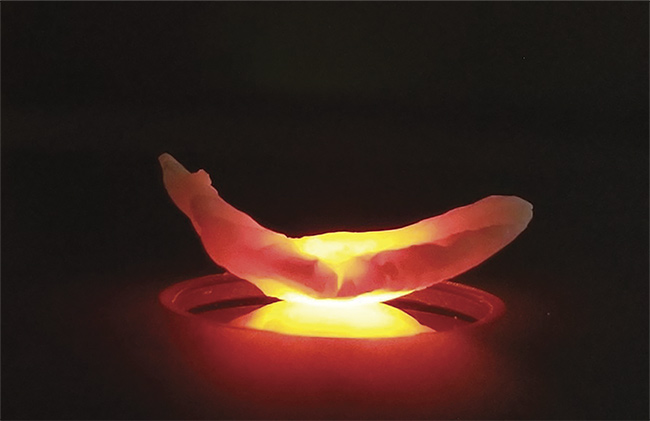Shoppers for fresh seafood often find themselves questioning the age of the fish they buy at the seafood counter. They may make an educated guess by smell at the store, or taste, after bringing it home.
Scientists have long sought an efficient, cost-effective way to determine the health and viability of fish stocks among harvested species. For these researchers, the age of the fish matters before it is ever reeled in. Historically, one way to weigh in on the answer is by counting growth markings, just as one would count rings on a tree to determine its age. In bony fish, the diffusion properties of the growth bands of otoliths — the hard, calcium carbonate structures of the skull behind the brain — enable bands to be counted and the age of the fish approximated. Technologies traditionally used for this purpose include x-ray and scanning electron microscopy.

A red snapper otolith irradiated
from beneath by near-infrared light shined through a Fourier transform near-infrared sample window.
Courtesy of Michelle Passerotti.
But the process can be hampered by human error. A group of researchers from the University of South Carolina, in cooperation with the National Marine Fisheries Service, were recently “caught up” in this line of research, and they used an optical technology called Fourier transform near-infrared (FT-NIR) spectroscopy to “bait” the scientists who monitor fish resources with a possible solution. In FT-NIR spectroscopy, a mathematical process is used to transfer raw data into the spectrum.
In a study funded by the South Carolina Sea Grant Consortium and published in the ICES Journal of Marine Science, researchers set their sights on analyzing red snapper, due to the species’ widespread availability and the regulation of its harvesting, according to Michelle Passerotti, a doctoral student in the Department of Biological Sciences at the University of South Carolina. Red snappers also live longer than other monitored species, allowing a broader range of ages to be examined. The traditional processes for investigating the growth bands of the fish’s otoliths are labor-intensive, however.
“These otoliths are the size of, say, lima beans when they are at their largest (so most are smaller than that),” Passerotti said. “Each one must be cross-sectioned through the core to less than 1-mm-thick sections, which are then mounted on slides and viewed under a microscope to visualize fine growth bands. The degree of definition can vary widely, depending on the environmental and growth history of the fish, so some bands are harder to see/interpret than others.”
In the study, the researchers reported that they scanned 1357 red snapper otoliths with an FT-NIR spectrometer, and they produced models by regressing signatures alongside traditionally estimated ages. The NIR light penetration varied in older adults, although Passerotti said older individuals were rare in the general population. Overall, the data was deciphered by three readers, and the mean squared error amounted to ≤1.8 years.
The results may prove to be a good indication for how accurate the FT-NIR method could be when used on a broader scale. And the data can be collected in a fraction of the time it takes to accomplish traditional aging of fish populations.
“FT-NIRS is the first technology that has shown such widespread promise in improving throughput of age estimation at the production level,” Passerotti said.
In the future, the question of just how old that fish is may be answered well before anyone sees it at the seafood counter.